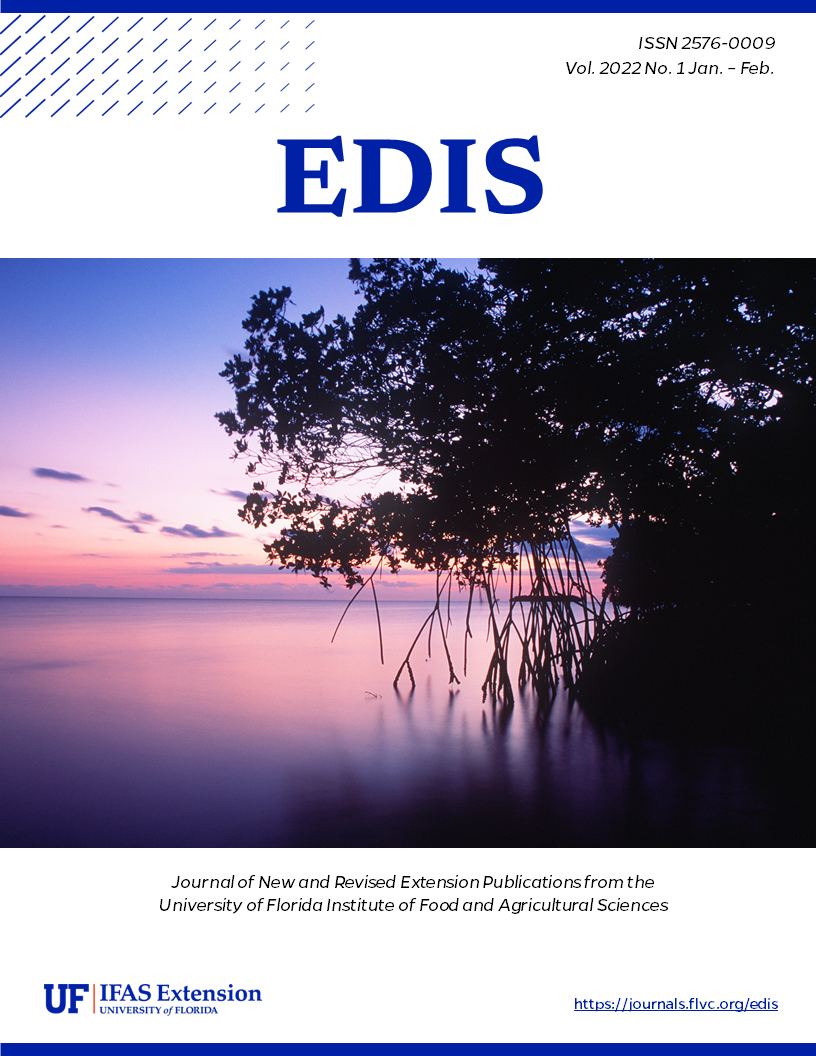Abstract
The Featured Creatures collection provides in-depth profiles of insects, nematodes, arachnids and other organisms relevant to Florida. These profiles are intended for the use of interested laypersons with some knowledge of biology as well as academic audiences.
Rice root-knot disease is caused by different Meloidogyne species (Meloidogyne graminicola, M. hainanensis, M. incognita, M. javanica, M. arenaria, M. oryzae, M. salasi, and M. tryticoryzae). However, Meloidogyne graminicola is considered the most damaging root-knot species to Asian rice cultivation due to its ability to survive under flooded soil conditions. This nematode has been found in rice nurseries, rainfed upland rice and lowland rice but is also widespread in deep-water, irrigated rice production systems. Yield loss due to Meloidogyne graminicola ranges from 28%–87% depending on disease severity and cultivar.
References
Abad P, Gouzy J, Aury JM, Castagnone-Sereno P, Danchin EG, Deleury E, Perfus-Barbeoch L, Anthouard V, Artiguenave F, Blok VC, Caillaud MC. 2008. Genome sequence of the metazoan plant-parasitic nematode Meloidogyne incognita. Nature Biotechnology 26:909-915. https://doi.org/10.1038/nbt.1482
Bellafiore S, Jougla C, Chapuis É, Besnard G, Suong M, Vu, PN, De Waele D, Gantet P, Thi XN. 2015. Intraspecific variability of the facultative meiotic parthenogenetic root-knot nematode (Meloidogyne graminicola) from rice fields in Vietnam. Comptes Rendus Biologies 338: 471-483. https://doi.org/10.1016/j.crvi.2015.04.002
Bridge J, Plowright RA, Peng D. 2005. Nematode parasites of rice. Plant parasitic nematodes in subtropical and tropical agriculture 2: 87-130. https://doi.org/10.1079/9780851997278.0087
Bui HX, Hadi BA, Oliva R, Schroeder NE. 2020. Beneficial bacterial volatile compounds for the control of root-knot nematode and bacterial leaf blight on rice. Crop Protection 135: 104792. https://doi.org/10.1016/j.cropro.2019.04.016
Cabasan MT, Kumar A, Bellafiore S, De Waele D. 2014. Histopathology of the rice root-knot nematode, Meloidogyne graminicola, on Oryza sativa and O. glaberrima. Nematology 16: 73-81. https://doi.org/10.1163/15685411-00002746
Chen JW, Chen SY, Ning XL, Shi CH, Cheng X, Xiao S, Liu GK. 2019. First report of Meloidogyne graminicola infecting Chinese Chive in China. Plant Disease 103: 11, 2967. https://doi.org/10.1094/PDIS-06-19-1241-PDN https://doi.org/10.1094/PDIS-06-19-1241-PDN
Dutta TK, Ganguly AK, Gaur HS. 2012. Global status of rice root-knot nematode, Meloidogyne graminicola. African Journal of Microbiology Research 6: 6016-6021. https://doi.org/10.5897/AJMR12.707
EPPO. 2017. EPPO Alert List - Meloidogyne graminicola, Rice root-knot nematode. https://www.eppo.int/ACTIVITIES/plant_quarantine/alert_list_nematodes/meloidogyne_graminicola
Handoo, ZA, Klassen, W, Abdul Baki, AA, Bryan, HH, Wang, Q. 2003. First record of rice-root nematode (Meloidogyne graminicola) in florida [abstract]. Journal of Nematology. 35: 342.
Htay C, Peng H, Huang W, Kong L, He W, Holgado R, Peng D. 2016. The development and molecular characterization of a rapid detection method for rice root-knot nematode (Meloidogyne graminicola). European Journal of Plant Pathology 146: 281-291. https://doi.org/10.1007/s10658-016-0913-y
Kyndt T, Fernandez D, Gheysen G. 2014. Plant-parasitic nematode infections in rice: molecular and cellular insights. Annual Review of Phytopathology 52: 135-153. https://doi.org/10.1146/annurev-phyto-102313-050111
Mantelin S, Bellafiore S, Kyndt T. 2017. Meloidogyne graminicola: a major threat to rice agriculture. Molecular Plant Pathology 18: 3-15. https://doi.org/10.1111/mpp.12394
MacGowan, JB, and Langdon, KR. 1989. Hosts of the rice root-knot nematode Meloidogyne graminicola. Fla. Department Agriculture and Consumer Services, Division of Plant Industry. https://www.fdacs.gov/content/download/10961/file/nem172.pdf
Oliveira, CJ, Subbotin, SA, Álvarez-Ortega, S, Desaeger, J, Brito, JA, Xavier, KV, Freitas, LG, Vau, S, Inserra, RN. 2019. Morphological and molecular identification of two Florida populations of foliar nematodes (Aphelenchoides spp.) isolated from strawberry with the description of Aphelenchoides pseudogoodeyi sp. n. (Nematoda: Aphelenchoididae) and notes on their bionomics. Plant Disease 103: 2825-2842. https://doi.org/10.1094/PDIS-04-19-0752-RE
Pankaj Hs, Singh K, Lal J. 2015. Management of rice root-knot nematode, Meloidogyne graminicola in rice (Oryza sativa). Indian Journal of Agricultural Sciences 85:701-704.
Sacchi S, Torrini G, Marianelli L, Mazza G, Fumagalli A, Cavagna B, Ciampitti M, Roversi PF. 2021. Control of Meloidogyne graminicola a Root-Knot Nematode Using Rice Plants as Trap Crops: Preliminary Results. Agriculture 11:37. https://doi.org/10.3390/agriculture11010037
Trinh QP, Le TM, Nguyen TD, Nguyen HT, Liebanas G, Nguyen TA. 2019. Meloidogyne daklakensis n. sp. (Nematoda: Meloidogynidae), a new root-knot nematode associated with Robusta coffee (Coffea canephora Pierre ex A. Froehner) in the Western Highlands, Vietnam. J Helminthol 93: 242-254. https://doi.org/10.1017/S0022149X18000202
Yik CP, Birchfield W. 1979. Host studies and reactions of rice cultivars to Meloidogyne graminicola. Phytopathology 69:497-499. https://doi.org/10.1094/Phyto-69-497

